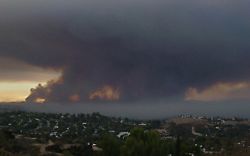Smoke
Smoke is the airborne solid and liquid particulates and gases evolved when a material undergoes pyrolysis or combustion, together with the quantity of air that is entrained or otherwise mixed into the mass. It is commonly an unwanted byproduct of fires (including stoves and lamps) and fireplaces, but may also be used for pest control (fumigation), communication (smoke signals), defense (smoke-screen) or inhalation of tobacco or other drugs. Smoke is sometimes used as a flavoring agent and preservative for various foodstuffs. Smoke is also sometimes a component of internal combustion engine exhaust gas, particularly diesel exhaust.
Smoke inhalation is the primary cause of death in victims of indoor fires. The smoke kills by a combination of thermal damage, poisoning and pulmonary irritation caused by carbon monoxide, hydrogen cyanide, and other combustion products.
Chemical composition
The composition of smoke depends on the nature of the burning fuel and the conditions of combustion.
Fires with high availability of oxygen burn in high temperature and with small amount of smoke produced; the particles are mostly composed of ash, or in large temperature differences, of condensed aerosol of water. High temperature also leads to production of nitrogen oxides. Sulfur content yields sulfur dioxide. Carbon and hydrogen get completely oxidized to carbon dioxide and water. Fires burning with lack of oxygen produce significantly wider palette of compounds, many of them toxic. Partial oxidation of carbon produces carbon monoxide, nitrogen-containing materials can yield hydrogen cyanide, ammonia, and nitrogen oxides. Content of chlorine (eg. in polyvinyl chloride) or other halogens may lead to production of hydrogen chloride, phosgene, dioxin, and chloromethane, bromomethane, and other halocarbons.
Pyrolysis of the burning material also results in the production of large amounts of hydrocarbons, both aliphatic (methane, ethane, ethylene, acetylene) and aromatic (benzene and its derivates, polycyclic aromatic hydrocarbons; eg. benzo[a]pyrene, studied as a cancerogen, or retene), terpenes. Heterocyclic compounds may be also present. Heavier hydrocarbons may condense as tar.
Presence of sulfur can lead to formation of eg. hydrogen sulfide, carbonyl sulfide, sulfur dioxide, carbon disulfide, and thiols; especially thiols tend to get adsorbed on surfaces and produce lingering odor even long after the fire. Partial oxidation of the released hydrocarbons yields in a wide palette of other compounds: aldehydes (eg. formaldehyde, acrolein, and furfural), ketones, alcohols (often aromatic, eg. phenol, guaiacol, syringol, catechol, and cresols), carboxylic acids (formic acid, acetic acid, etc.).
The visible particles in such smokes are most commonly composed of carbon (soot). Other particulates may be composed of drops of condensed tar, or solid particles of ash. Content of metals yields particles of metal oxides. Particles of inorganic salts may also be formed, like ammonium sulfate, ammonium nitrate. Many organic compounds, typically the aromatic hydrocarbons, may be also adsorbed on the surface of the solid particles.
Smoke emissions may contain characteristic trace elements. Vanadium is present in emissions from oil fired power plants and refineries; oil plants also emit some nickel. Coal combustion produces emissions containing selenium, arsenic, chromium, cobalt, copper, and aluminium.
Some components of smoke are characteristic for the combustion source. Guaiacol and its derivates are products of pyrolysis of lignin and are characteristic for wood smoke; other markers are syringol and derivates, and other methoxy phenols. Retene, a product of pyrolysis of conifer trees, is an indicator of forest fires. Levoglucosan is a pyrolysis product of cellulose. Hardwood vs softwood smokes differ in the ratio of guaiacols/syringols. Markers for vehicle exhaust include polycyclic aromatic hydrocarbons, hopanes, steranes, and specific nitroarenes (eg. 1-nitropyrene). The ratio of hopanes and steranes to elemental carbon can be used to distinguish between emissions of gasoline and diesel engines.[1]
Dangers of smoke
Smoke from oxygen-deprived fires contains a significant amount of compounds that are flammable. A cloud of smoke, in contact with atmospheric oxygen, therefore has the potential of being ignited either by another open flame in the area, or by its own temperature. This leads to effects like backdraft and flashover.
Many compounds of smoke from fires are highly toxic and/or irritant. The most dangerous is carbon monoxide, leading to carbon monoxide poisoning, sometimes with supporting effect of hydrogen cyanide and phosgene. Smoke inhalation can therefore quickly lead to incapacitation and loss of consciousness.
Smoke can obscure visibility, impeding occupant exiting from fire areas. In fact, the poor visibility due to the smoke that was in the Worcester Cold Storage Warehouse fire in Worcester, Massachusetts was the exact reason why the trapped rescue firefighters couldn't evacuate the building in time. Due to the striking similarity that each floor shared, the dense smoke caused the firefighters to become disoriented.
Visible and invisible particles of combustion
Depending on particle size, smoke can be visible or invisible to the naked eye. This is best illustrated when toasting bread in a toaster. As the bread heats up, the products of combustion increase in size. These particles begin as invisible but become visible if the toast is burnt.
See also
- Firefighter
- Smoke detector
- Smog
- Smoking (cooking technique)
- Smoke-screen
- Smoke bomb
- Smoke signal
- Tobacco
Notes
- ↑ Contribution of Particulate Organic Compounds to Indoor and Personal Exposures Retrieved October 1, 2007.
ReferencesISBN links support NWE through referral fees
- Bowman, C., et al. Shedding new light on wood smoke: a risk factor for respiratory health Eur. Respir. J. 27:446-47, 2006. Retrieved October 1, 2007.
- Centers for Disease Control and Prevention (U.S.). Secondhand smoke: what it means to you. Rockville, MD: U.S. Dept. of Health and Human Services, 2006. OCLC: 70215796.
- Schwartz, Joel. The Wood Smoke Issue: Comparison of Fuel Emissions Burning Issues, 2002. Retrieved October 1, 2007.
External links
All links retrieved January 30, 2023.
Credits
New World Encyclopedia writers and editors rewrote and completed the Wikipedia article in accordance with New World Encyclopedia standards. This article abides by terms of the Creative Commons CC-by-sa 3.0 License (CC-by-sa), which may be used and disseminated with proper attribution. Credit is due under the terms of this license that can reference both the New World Encyclopedia contributors and the selfless volunteer contributors of the Wikimedia Foundation. To cite this article click here for a list of acceptable citing formats.The history of earlier contributions by wikipedians is accessible to researchers here:
The history of this article since it was imported to New World Encyclopedia:
Note: Some restrictions may apply to use of individual images which are separately licensed.


